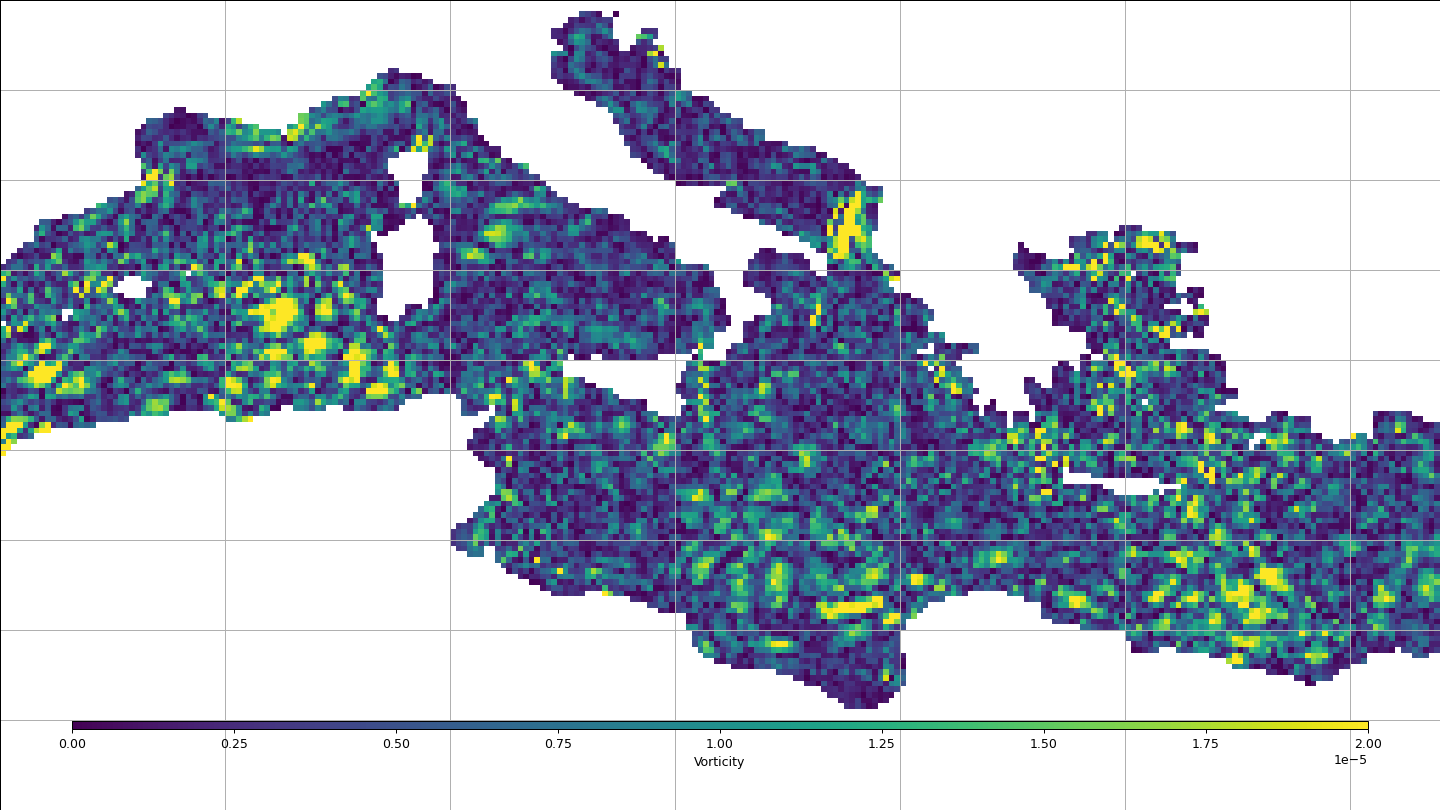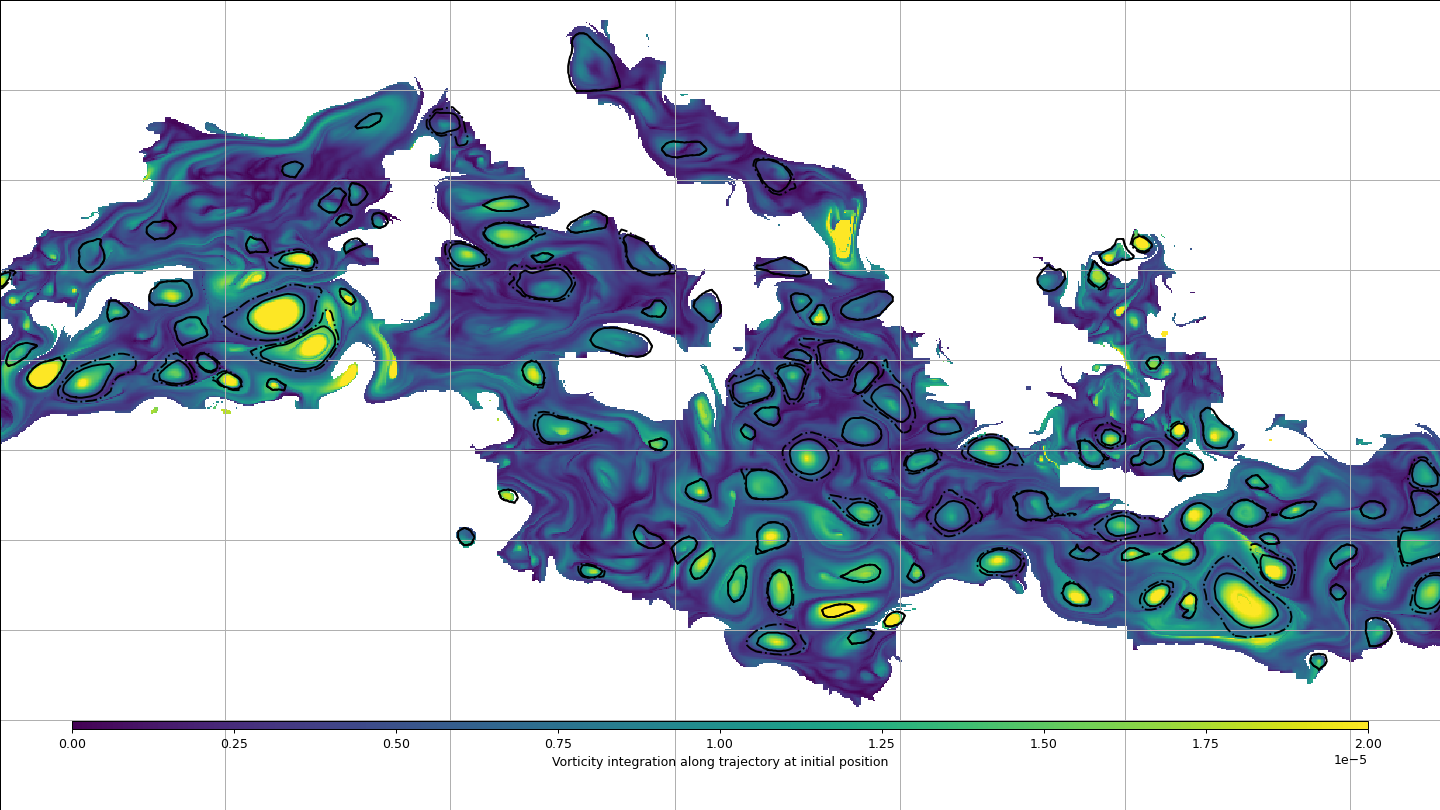Note
Go to the end to download the full example code or to run this example in your browser via Binder
LAVD experiment¶
Naive method to reproduce LAVD(Lagrangian-Averaged Vorticity deviation) method with a static velocity field. In the current example we didn’t remove a mean vorticity.
Method are described here:
Abernathey, Ryan, and George Haller. “Transport by Lagrangian Vortices in the Eastern Pacific”, Journal of Physical Oceanography 48, 3 (2018): 667-685, accessed Feb 16, 2021, https://doi.org/10.1175/JPO-D-17-0102.1
Transport by Coherent Lagrangian Vortices, R. Abernathey, Sinha A., Tarshish N., Liu T., Zhang C., Haller G., 2019, Talk a t the Sources and Sinks of Ocean Mesoscale Eddy Energy CLIVAR Workshop
import re
from matplotlib import pyplot as plt
from matplotlib.animation import FuncAnimation
from numpy import arange, meshgrid, zeros
from py_eddy_tracker.data import get_demo_path
from py_eddy_tracker.dataset.grid import RegularGridDataset
from py_eddy_tracker.gui import GUI_AXES
from py_eddy_tracker.observations.observation import EddiesObservations
def start_ax(title="", dpi=90):
fig = plt.figure(figsize=(16, 9), dpi=dpi)
ax = fig.add_axes([0, 0, 1, 1], projection=GUI_AXES)
ax.set_xlim(0, 32), ax.set_ylim(28, 46)
ax.set_title(title)
return fig, ax, ax.text(3, 32, "", fontsize=20)
def update_axes(ax, mappable=None):
ax.grid()
if mappable:
cb = plt.colorbar(
mappable,
cax=ax.figure.add_axes([0.05, 0.1, 0.9, 0.01]),
orientation="horizontal",
)
cb.set_label("Vorticity integration along trajectory at initial position")
return cb
kw_vorticity = dict(vmin=0, vmax=2e-5, cmap="viridis")
class VideoAnimation(FuncAnimation):
def _repr_html_(self, *args, **kwargs):
"""To get video in html and have a player"""
content = self.to_html5_video()
return re.sub(
r'width="[0-9]*"\sheight="[0-9]*"', 'width="100%" height="100%"', content
)
def save(self, *args, **kwargs):
if args[0].endswith("gif"):
# In this case gif is used to create thumbnail which is not used but consume same time than video
# So we create an empty file, to save time
with open(args[0], "w") as _:
pass
return
return super().save(*args, **kwargs)
Data¶
To compute vorticity (\(\omega\)) we compute u/v field with a stencil and apply the following equation with stencil method :
g = RegularGridDataset(
get_demo_path("dt_med_allsat_phy_l4_20160515_20190101.nc"), "longitude", "latitude"
)
g.add_uv("adt")
u_y = g.compute_stencil(g.grid("u"), vertical=True)
v_x = g.compute_stencil(g.grid("v"))
g.vars["vort"] = v_x - u_y
Display vorticity field

Particles¶
Particles specification
step = 1 / 32
x_g, y_g = arange(0, 36, step), arange(28, 46, step)
x, y = meshgrid(x_g, y_g)
original_shape = x.shape
x, y = x.reshape(-1), y.reshape(-1)
print(f"{len(x)} particles advected")
# A frame every 8h
step_by_day = 3
# Compute step of advection every 4h
nb_step = 2
kw_p = dict(
nb_step=nb_step, time_step=86400 / step_by_day / nb_step, u_name="u", v_name="v"
)
# Start a generator which at each iteration return new position at next time step
particule = g.advect(x, y, **kw_p, rk4=True)
663552 particles advected
LAVD¶
lavd = zeros(original_shape)
# Advection time
nb_days = 8
# Nb frame
nb_time = step_by_day * nb_days
i = 0.0
Anim¶
Movie of LAVD integration at each integration time step.
def update(i_frame):
global lavd, i
i += 1
x, y = particule.__next__()
# Interp vorticity on new_position
lavd += abs(g.interp("vort", x, y).reshape(original_shape) * 1 / nb_time)
txt.set_text(f"T0 + {i / step_by_day:.2f} days of advection")
pcolormesh.set_array(lavd / i * nb_time)
return pcolormesh, txt
kw_video = dict(frames=arange(nb_time), interval=1000.0 / step_by_day / 2, blit=True)
fig, ax, txt = start_ax(dpi=60)
x_g_, y_g_ = (
arange(0 - step / 2, 36 + step / 2, step),
arange(28 - step / 2, 46 + step / 2, step),
)
# pcolorfast will be faster than pcolormesh, we could use pcolorfast due to x and y are regular
pcolormesh = ax.pcolorfast(x_g_, y_g_, lavd, **kw_vorticity)
update_axes(ax, pcolormesh)
_ = VideoAnimation(ax.figure, update, **kw_video)
Final LAVD¶
Format LAVD data
Display final LAVD with py eddy tracker detection. Period used for LAVD integration (8 days) is too short for a real use, but choose for example efficiency.
fig, ax, _ = start_ax()
mappable = lavd.display(ax, "lavd", **kw_vorticity)
EddiesObservations.load_file(get_demo_path("Anticyclonic_20160515.nc")).display(
ax, color="k"
)
EddiesObservations.load_file(get_demo_path("Cyclonic_20160515.nc")).display(
ax, color="k"
)
_ = update_axes(ax, mappable)

Total running time of the script: ( 0 minutes 8.457 seconds)